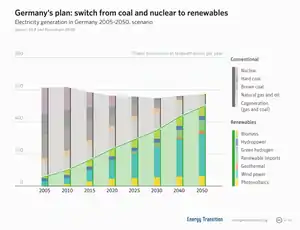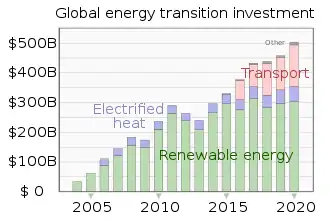Energy transition
Energy transition is a significant structural change in an energy system.[2] Historically, these changes have been driven by the demand for and availability of different fuels.[3] Energy transitions can also result from depletion of energy sources, for example whale oil for illumination and wood for iron smelting in Europe. The current transition to renewable energy, and perhaps other types of sustainable energy, differs as it is largely driven by a recognition that global carbon emissions must be brought to zero, and since fossil fuels are the largest single source of carbon emissions, the quantity of fossil fuels that can be produced is limited by the COP21 Paris Agreement of 2015 to keep global warming below 1.5 °C. In recent years, the term energy transition has been coined in the framework of a move towards sustainability through increased integration of renewable energy in the realm of daily life.

An example of transition toward sustainable energy is the shift by Germany (Energiewende) and Switzerland,[4] to decentralized renewable energy, and energy efficiency. Although so far these shifts have been replacing nuclear energy, their declared goal was the coal phase-out, reducing non-renewable energy sources[5] and the creation of an energy system based on 60% renewable energy by 2050.[6] As of 2018, the 2030 coalition goals are to achieve 65% renewables in electricity production until 2030 in Germany.[7] Another such example is the drive to transition from internal combustion engine powered vehicles to electric vehicles as a way to reduce the global reliance on fossil fuels and reduce greenhouse gas emissions.[8] This transition in particular however has begun to stimulate debate considering it requires a tenfold increase in mineral extraction and therefore will lead to an increase of the mining processes themselves and of the associated environmental and societal impacts. A potential solution that has arisen for this energy transition dilemma is to explore collection of minerals from new sources like polymetallic nodules lying on the seabed.[9] Ongoing research is exploring this as a way to facilitate the energy transition in a more sustainable manner.
Defining the term "energy transition"
Levelized cost of energy (LCOE) is a measure of the average net present cost of electricity generation for a generating plant over its lifetime.

An "energy transition" designates a significant change for an energy system that could be related to one or a combination of resource use, system structure, scale, economics, end use behaviour and energy policy. An 'energy transition' is usefully defined as a change in the state of an energy system as opposed to a change in an individual energy technology or fuel source.[12] A prime example is the change from a pre-industrial system relying on traditional biomass and other renewable power sources (wind, water, and muscle power) to an industrial system characterized by pervasive mechanization (steam power) and the use of coal. Market shares reaching pre-specified thresholds are typically used to characterize the speed of transition (e.g. coal versus traditional biomass) and typical market share thresholds in the literature are 1%, 10% for the initial shares and 50%, 90% and 99% for outcome shares following a transition.[13]
However, since the adoption of the COP21 Paris Agreement in 2015,[14] the Energy Transition to Net Zero Carbon is defined as the downshift of fossil fuel production to stay within the carbon emissions budget to limit global warming to less than 1.5 °C.[15] The term "Net Zero" includes recognition that some atmospheric CO2 is sequestered in the growth of plants and animals, and that this natural sequestration could be enhanced through soil conservation, reforestation and protection of peatland, wetland and marine environments.
The term 'energy transition' could also encompasses a reorientation of policy and this is often the case in public debate about energy policy. For example, this could imply a rebalance of demand to supply and a shift from centralized to distributed generation (for example, producing heat and power in very small cogeneration units), which should replace overproduction and avoidable energy consumption with energy-saving measures and increased efficiency.[16] In a broader sense the energy transition could also entail a democratization of energy[17] or a move towards increased sustainability.
History
Historic energy transitions are most broadly described by Vaclav Smil.[3] Contemporary energy transitions differ in terms of motivation and objectives, drivers and governance. The layout of the world's energy systems has changed significantly over time. Until the 1950s, the economic mechanism behind energy systems was local rather than global.[18] As development progressed, different national systems became more and more integrated becoming the large, international systems seen today. Historical transition rates of energy systems have been extensively studied.[19] While historical energy transitions were generally protracted affairs, unfolding over many decades, this does not necessarily hold true for the present energy transition, which is unfolding under very different policy and technological conditions.[20]
For current energy systems, many lessons can be learned from history.[21][22] The need for large amounts of firewood in early industrial processes in combination with prohibitive costs for overland transportation led to a scarcity of accessible (e.g. affordable) wood and it has been found that eighteenth century glass-works “operated like a forest clearing enterprise.[23] When Britain had to resort to coal after largely having run out of wood, the resulting fuel crisis triggered a chain of events that two centuries later culminated in the Industrial Revolution.[24][25] Similarly, increased use of peat and coal was vital elements paving the way for the Dutch Golden Age roughly spanning the entire 17th century.[26] Another example where resource depletion triggered technological innovation and a shift to new energy sources in 19th Century whaling and how whale oil eventually became replaced by kerosene and other petroleum-derived products.[27] With the success of a rapid energy transition it is also conceivable that there will be government buyouts or bailouts of coal mining regions.
See also
References
- Friedlingstein et al. 2019.
- "World Energy Council. 2014. Global Energy Transitions".
- Smil, Vaclav. 2010. Energy Transitions. History, Requirements, Prospects. Praeger
- Notter, Dominic A. (2015-01-01). "Small country, big challenge: Switzerland's upcoming transition to sustainable energy". Bulletin of the Atomic Scientists. 71 (4): 51–63. Bibcode:2015BuAtS..71d..51N. doi:10.1177/0096340215590792. ISSN 0096-3402.
- Federal Ministry for the Environment (29 March 2012). Langfristszenarien und Strategien für den Ausbau der erneuerbaren Energien in Deutschland bei Berücksichtigung der Entwicklung in Europa und global [Long-term Scenarios and Strategies for the Development of Renewable Energy in Germany Considering Development in Europe and Globally] (PDF). Berlin, Germany: Federal Ministry for the Environment (BMU). Archived from the original (PDF) on 27 October 2012.
- https://www.bmwi.de/BMWi/Redaktion/PDF/V/vierter-monitoring-bericht-energie-der-zukunft-englische-kurzfassung,property=pdf,bereich=bmwi2012,sprache=de,rwb=true.pdf Archived 20 September 2016 at the Wayback Machine pg6
- "Das steht im Abschlusstext von Union und SPD". Sueddeutsche.de. 2018-09-04.
- Brennan, John W.; Barder, Timothy E. "Battery Electric Vehicles vs. Internal Combustion Engine Vehicles - A United States-Based Comprehensive Assessment" (PDF). Arthur D. Little. Retrieved 2021-01-20.
- Ali, Saleem (2020-06-02). "Deep sea mining: the potential convergence of science, industry and sustainable development?". Springer Nature Sustainability Community. Springer Nature Sustainability Community. Retrieved 2021-01-20.
- "Energy Transition Investment Hit $500 Billion in 2020 – For First Time". BloombergNEF. (Bloomberg New Energy Finance). 2021-01-19. Archived from the original on 2021-01-19.
- Chrobak, Ula (author); Chodosh, Sara (infographic) (2021-01-28). "Solar power got cheap. So why aren't we using it more?". Popular Science. Archived from the original on 2021-01-29. ● Chodosh's graphic is derived from data in "Lazard's Levelized Cost of Energy Version 14.0" (PDF). Lazard.com. Lazard. 2020-10-19. Archived (PDF) from the original on 2021-01-28.
- Grübler, A. (1991). "Diffusion: Long-term patterns and discontinuities". Technological Forecasting and Social Change. 39 (1–2): 159–180. doi:10.1016/0040-1625(91)90034-D.
- Grübler, A; Wilson, C.; Nemet, G. (2016). "Apples, oranges, and consistent comparisons of the temporal dynamics of energy transitions" (PDF). Energy Research & Social Science. 22 (12): 18–25. doi:10.1016/j.erss.2016.08.015.
- "The Paris Agreement". UNFCCC. Retrieved 2021-01-02.
- Rogelj, Joeri; Forster, Piers M.; Kriegler, Elmar; Smith, Christopher J.; Séférian, Roland (July 2019). "Estimating and tracking the remaining carbon budget for stringent climate targets". Nature. 571 (7765): 335–342. doi:10.1038/s41586-019-1368-z. ISSN 1476-4687.
- Louis Boisgibault, Fahad Al Kabbani (2020): Energy Transition in Metropolises, Rural Areas and Deserts. Wiley - ISTE. (Energy series) ISBN 9781786304995.
- Henrik Paulitz: Dezentrale Energiegewinnung - Eine Revolutionierung der gesellschaftlichen Verhältnisse. IPPNW. (Decentralized Energy Production - Revolutionizing Social Relations) Accessed 20 January 2012.
- Häfelse, W; Sassin, W (1977). "The global energy system". Annual Review of Energy. 2: 1–30. doi:10.1146/annurev.eg.02.110177.000245.
- Höök, Mikael; Li, Junchen; Johansson, Kersti; Snowden, Simon (2011). "Growth Rates of Global Energy Systems and Future Outlooks". Natural Resources Research. 21 (1): 23–41. doi:10.1007/s11053-011-9162-0.
- Sovacool, Benjamin K. (2016-03-01). "How long will it take? Conceptualizing the temporal dynamics of energy transitions". Energy Research & Social Science. 13: 202–215. doi:10.1016/j.erss.2015.12.020. ISSN 2214-6296.
- Podobnik, B. (1999). "Toward a sustainable energy regime: a long-wave interpretation of global energy shifts". Technological Forecasting and Social Change. 62 (3): 155–172. doi:10.1016/S0040-1625(99)00042-6.
- Rühl, C.; Appleby, P.; Fennema, F.; Naumov, A.; Schaffer, M. (2012). "Economic development and the demand for energy: a historical perspective on the next 20 years". Energy Policy. 50: 109–116. doi:10.1016/j.enpol.2012.07.039.
- Debeir, J.C.; Deléage, J.P.; Hémery, D. (1991). In the Servitude of Power: Energy and Civilisation Through the Ages. London: Zed Books. ISBN 9780862329426.
- Nef, J.U (1977). "Early energy crisis and its consequences". Scientific American. 237 (5): 140–151. Bibcode:1977SciAm.237e.140N. doi:10.1038/scientificamerican1177-140.
- Fouquet, R.; Pearson, P.J.G. (1998). "A thousand years of energy use in the United Kingdom". The Energy Journal. 19 (4): 1–41. doi:10.5547/issn0195-6574-ej-vol19-no4-1. JSTOR 41322802.
- Unger, R.W. (1984). "Energy sources for the dutch golden age: peat, wind, and coal". Research in Economic History. 9: 221–256.
- Bardi, U. (2007). "Energy prices and resource depletion: lessons from the case of whaling in the nineteenth century" (PDF). Energy Sources, Part B: Economics, Planning, and Policy. 2 (3): 297–304. doi:10.1080/15567240600629435.
Further reading
- Clean Tech Nation: How the U.S. Can Lead in the New Global Economy (2012) by Ron Pernick and Clint Wilder
- Deploying Renewables 2011 (2011) by the International Energy Agency
- Armstrong, Robert C., Catherine Wolfram, Robert Gross, Nathan S. Lewis, and M.V. Ramana et al. The Frontiers of Energy, Nature Energy, Vol 1, 11 January 2016.
- Reinventing Fire: Bold Business Solutions for the New Energy Era (2011) by Amory Lovins
- Renewable Energy Sources and Climate Change Mitigation (2011) by the IPCC
- Solar Energy Perspectives (2011) by the International Energy Agency
External links
| Wikimedia Commons has media related to Energy transition. |
- energytransition: about (German and world-wide) Energytransition (and Wiki about German Energiewende)
- Visual Capitalist, 31 October 2018, Iman Gosh, visualcapitalist.com: Visualizing the Global Transition to Green Energy

_-_renewable_energy.svg.png.webp)

